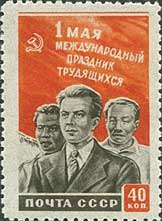Stamp: Working people of different nations under red flag (Soviet Union, USSR 1950)
Working people of different nations under red flag (Soviet Union, USSR 1950)
28 April (Soviet Union, USSR ) within release Labour day goes into circulation Stamp Working people of different nations under red flag face value 40 Russian kopek
| Stamp Working people of different nations under red flag in catalogues | |
|---|---|
| Michel: | Mi:SU 1461 |
Stamp is square format.
Also in the issue Labour day:
- Stamp - Working people of different nations under red flag face value 40;
- Stamp - People under red banner of Marx-Engels-Lenin-Stalin face value 1;
|
Data entry completed
43%
|
|
|---|---|
| Stamp Working people of different nations under red flag in digits | |
| Country: | Soviet Union, USSR |
| Date: | 1950-04-28 |
| Format: | Stamp |
| Face Value: | 40 Russian kopek |
Stamp Working people of different nations under red flag it reflects the thematic directions:
A flag is a piece of fabric (most often rectangular or quadrilateral) with a distinctive design that is used as a symbol, as a signaling device, or as decoration. The term flag is also used to refer to the graphic design employed, and flags have since evolved into a general tool for rudimentary signalling and identification, especially in environments where communication is similarly challenging (such as the maritime environment where semaphore is used). National flags are patriotic symbols with varied wide-ranging interpretations, often including strong military associations due to their original and ongoing military uses. Flags are also used in messaging, advertising, or for other decorative purposes. The study of flags is known as vexillology, from the Latin word vexillum, meaning flag or banner.
A festival is an event celebrated by a community and centering on some characteristic aspect or aspects of that community and its religion or cultures. It is often marked as a local or national holiday, mela, or eid. A festival constitutes typical cases of glocalization, as well as the high culture-low culture interrelationship. Next to religion and folklore, a significant origin is agricultural. Food is such a vital resource that many festivals are associated with harvest time. Religious commemoration and thanksgiving for good harvests are blended in events that take place in autumn, such as Halloween in the northern hemisphere and Easter in the southern.
A people is a plurality of persons considered as a whole, as is the case with an ethnic group or nation. Collectively, for example, the contemporary Frisians and Danes are two related Germanic peoples, while various Middle Eastern ethnic groups are often linguistically categorized as Semitic peoples.
A symbol is a mark, sign, or word that indicates, signifies, or is understood as representing an idea, object, or relationship. Symbols allow people to go beyond what is known or seen by creating linkages between otherwise very different concepts and experiences. All communication (and data processing) is achieved through the use of symbols. Symbols take the form of words, sounds, gestures, ideas, or visual images and are used to convey other ideas and beliefs. For example, a red octagon is a common symbol for "STOP"; on maps, blue lines often represent rivers; and a red rose often symbolizes love and compassion. Numerals are symbols for numbers; letters of an alphabet may be symbols for certain phonemes; and personal names are symbols representing individuals.



